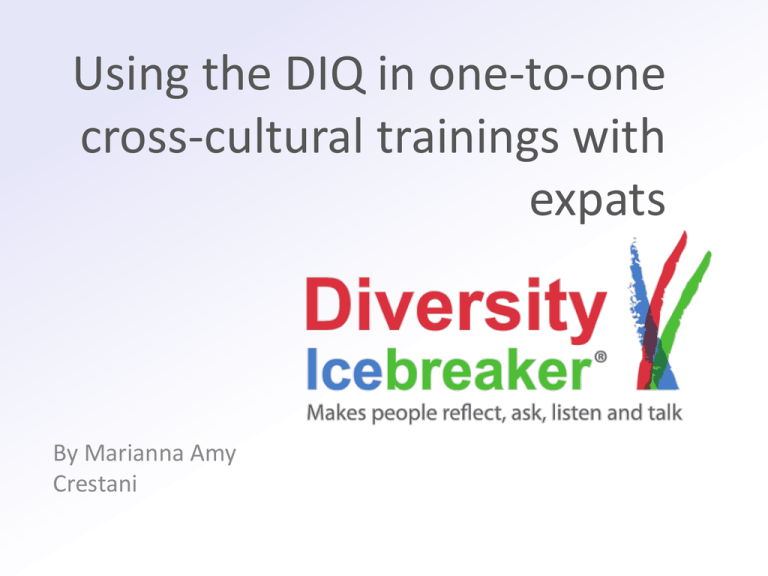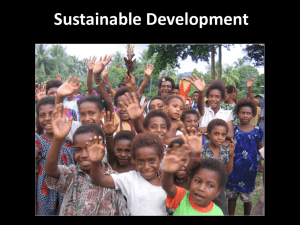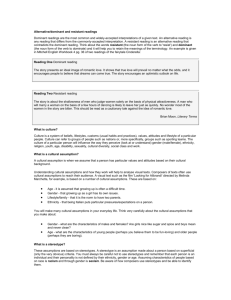Diversity Icebreaker - presentation sales
advertisement

Using the DIQ in one-to-one cross-cultural trainings with expats By Marianna Amy Crestani Overview 1. The world of global mobility 2. Steps 1 – 6 : culture is…; filling in and scoring; meaning of the colors; profiles; connecting colors; results 3. Some spontaneous connections 4. Behind the DI – Human Factors AS Norway The world of global mobility Core areas covered during a cross-cultural training with expats: •Cultural Self-Awareness •Understanding Cultural Differences •Country Specific Information •Intercultural communication •Adjustment issues •Dealing with change •Action plan BUT... How can we effectively break the ice, create rapport and position the training at a deeper level than a list of dos and don’ts? Step 1: culture is…. AFFINITY GROUP EXAMPLES National German, Italian, British, French Regional Northern/Southern Italy, Vicentino / Venetian, Veneto/Lombardia Gender Male and Female Socio-economic class Rich and poor, middle class Political Socialist, Liberal Education Level Secondary school, graduate,PhD Religion Catholic, Protestant, Muslim, Hindu, Christian, Jewish Age Different generations Physical ability Deaf, blind, wheelchair Sexual orientation Gay, lesbian, bisexual Organizational Organization that you work for Functional HR, Project Management, Information Systems And… Specific of individual – INHERITED AND LEARNED PERSONALITY Specific to group or category LEARNED CULTURE HUMAN NATURE Universal – INHERITED Step 2: filling in and scoring 1. Step 3: meaning of the colors • When you think of blue what are the very first things that come to your mind? • ‘Have you ever noticed what colour dress code is generally used in more formal organizations or professional contexts?’ ‘And what do formal organizations remind you of’? • Step 3: meaning of the colors • ‘And what about the colour green… what are the first things that come to your mind when you think about green?’ • ‘What comes with life and evolution?’ Step 3: meaning of the colors • ‘And what about the colour red… what are the first things that come to your mind when you think about red?’ • ‘And what do heart, passion and fire have in common?’ Step 4: profiles from the dominant to the non dominant ones Blue – structure and processes of organizations – logical thinking, communicating with a purpose, rationality; Green – life and evolution – creativity, imagination, big picture; Red – heart and passion – emotions, interaction, getting energy from being with other people. Step 5: connecting colors •What are the main features of the other colour groups? •How do the other colour groups see you? •How do you see the other colour groups? •What tips would you give to the other colour groups to successfully interact and work with you? •What should you within your dominant colour group be careful of if you ‘have too much of it’? Step 6: closure Stress 3 important points: •Both in a professional and in a nonprofessional context we need all 3 colour-profiles. •These 3 colour-profiles contribute to the creation of a new concept of culture where national differences are overcome by colour commonalities. •Self-awareness of when we are more Blue, Green or Red is of fundamental importance for an international assignment. Some spontaneous connections •‘I am a project manager… therefore I really see myself in the blue description’; •‘I am from Latin America… therefore I understand why my dominant colour is red’; •‘I work in marketing.. therefore I need to be green’; •‘I am a woman…and I now understand why I more ‘red’ in my home and more ‘blue’ at work, etc… Behind the Diversity Icebreaker Human Factors AS • • • • An international management consultant company specializing in teams, leadership, cultural diversity, communication, project leadership, and measurement instruments since 1993 Practitioner as well as academically orientated. Open Innovation Model Openness and Generosity – the core values • • • Red, Blue and Green established as categories for communication in 1995 DI Questionnaire emerged in 1997, the version in use unchanged since 2005 The classical seminar pattern emerged in 2003 Behind the Diversity Icebreaker Human Factors AS – contact Human Factors AS, Norway www.human-factors.no Diversity Icebreaker Network on LinkedIn Diversity Icebreaker – International on Facebook











